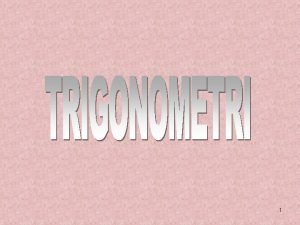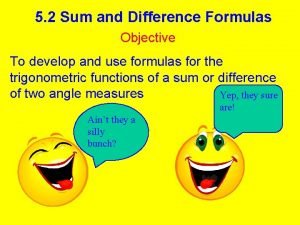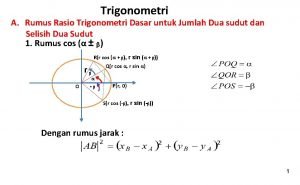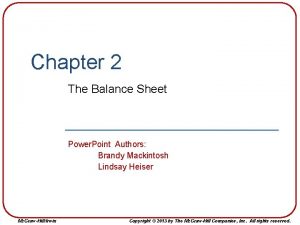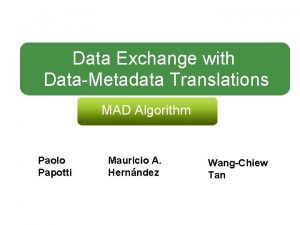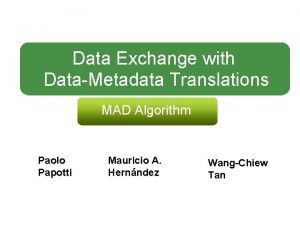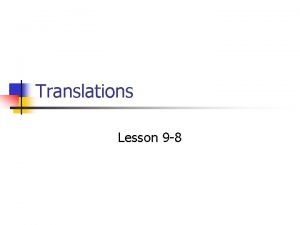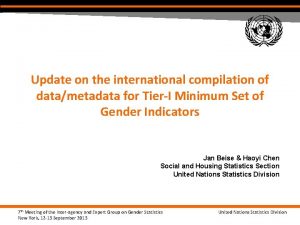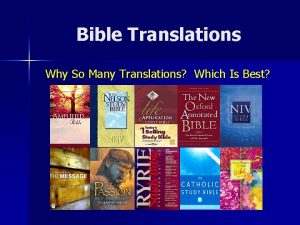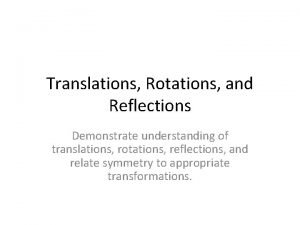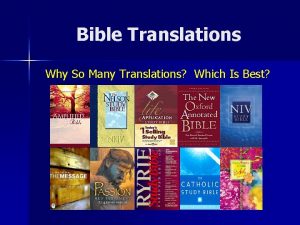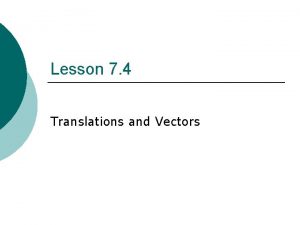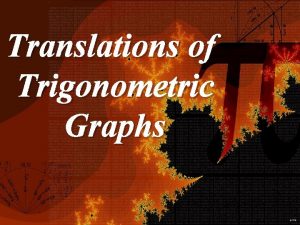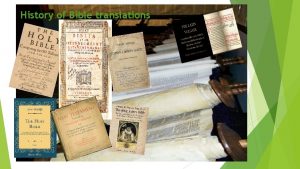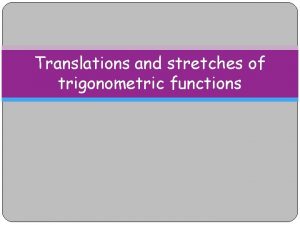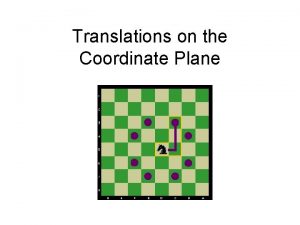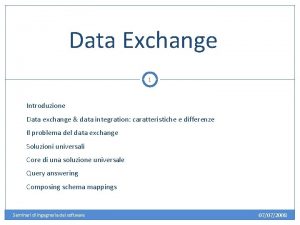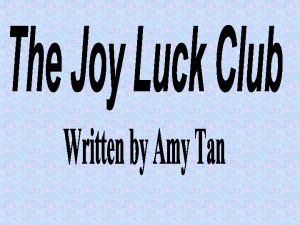Data Exchange with DataMetadata Translations WangChiew Tan Mauricio




![Data-to-Data • Mapping Generation Algorithm: [PVMHF 2002] – Input: Source and Target schemas, and Data-to-Data • Mapping Generation Algorithm: [PVMHF 2002] – Input: Source and Target schemas, and](https://slidetodoc.com/presentation_image/6a9e23baabc2aea67675ff708b732e44/image-5.jpg)





![Data-to-Metadata Now we want to support the opposite operation [example from Miller 98] The Data-to-Metadata Now we want to support the opposite operation [example from Miller 98] The](https://slidetodoc.com/presentation_image/6a9e23baabc2aea67675ff708b732e44/image-11.jpg)





![Query Generation: two-phase algorithm [PVMHF 02] Phase 1: Phase 2: Q 1 shreds the Query Generation: two-phase algorithm [PVMHF 02] Phase 1: Phase 2: Q 1 shreds the](https://slidetodoc.com/presentation_image/6a9e23baabc2aea67675ff708b732e44/image-17.jpg)








- Slides: 25

Data Exchange with Data-Metadata Translations Wang-Chiew Tan Mauricio A. Hernández IBM Almaden Research Center UC Santa Cruz Paolo Papotti Università Roma Tre VLDB 2008 August 24 -- Auckland, New Zealand

Data-Metadata Translations • Data exchange scenarios may involve metadata transformations. – E. g. , Pivot/Unpivot in spreadsheets. [example from Miller 98] • • 2 Mapping systems support Data-to-Data transformations with fixed schemas. Goal: Extend mapping systems to support Data. Metadata Translations.

Mapping Systems Source schema S GUI Target schema T IBM Clio Hep. Tox MS ADO. net Declarative (internal) representation Altova Map. Force Stylus. Studio Executable code (XSLT, XQuery, Java) I 3 J BEA Aqualogic Data exchange

Outline 1. Data and Metadata translations 2. Generation Algorithms Data-to-Data Mapping Generation Metadata-to-Data Query Generation Graphic Design Data-to-Metadata 3. Results & Discussion Experiments Related Work Conclusion Graphic Design
![DatatoData Mapping Generation Algorithm PVMHF 2002 Input Source and Target schemas and Data-to-Data • Mapping Generation Algorithm: [PVMHF 2002] – Input: Source and Target schemas, and](https://slidetodoc.com/presentation_image/6a9e23baabc2aea67675ff708b732e44/image-5.jpg)
Data-to-Data • Mapping Generation Algorithm: [PVMHF 2002] – Input: Source and Target schemas, and correspondences. – Output: declarative schema mapping • For example: Source: Rcd Sales: Set. Of Rcd country region style shipdate units price Target: Rcd Country. Sales: Set. Of Rcd country Sales: Set. Of Rcd style shipdate units id for $s in Source. Sales exists $t in Target. Country. Sales, $c in $t. Sales where $t. country = $s. country and $c. style = $s. style and $c. shipdate = $s. shipdate and $c. units = $s. units

Mappings for $s in Source. Sales exists $t in Target. Country. Sales, $c in $t. Sales where $t. country = $s. country and $c. style = $s. style and $c. shipdate = $s. shipdate and $c. units = $s. units • Query Generation into multiple query languages: – Input: a data to data schema mapping – Output: a query script (XQuery, XSLT, SQL, etc. ) for $x 0 in $doc/Source/Sales return ( <Country. Sales> <country> { $x 0/country/text() } </country> …

“State-of-the-art” Metadata-to-Data How can we transform the following source data into the corresponding target? Source. Sales month USA UK Italy Jan 120 223 89 Feb 83 168 56 Target. Sales month country units Jan Jan Feb Feb USA UK Italy 120 223 89 83 168 56 Schema mapping m 1 Source: Rcd Target: Rcd Sales: Set. Of Rcd month “USA” USA country UK units Italy 7 m 1: for $s in Source. Sales exists $t in Target. Sales where $t. month = $s. month and $t. country = “USA” and $t. units = $s. USA

“State-of-the-art” Metadata-to-Data How can we transform the following source data into the corresponding target? Source. Sales month USA UK Italy Jan 120 223 89 Feb 83 168 56 Target. Sales month country units Jan Jan Feb Feb USA UK Italy 120 223 89 83 168 56 Schema mapping m 2 Source: Rcd Sales: Set. Of Rcd month “UK” USA UK Italy 8 Target: Rcd Sales: Set. Of Rcd month country units m 1: for $s in Source. Sales exists $t in Target. Sales where $t. month = $s. month and $t. country = “USA” and $t. units = $s. USA m 2: for $s in Source. Sales exists $t in Target. Sales where $t. month = $s. month and $t. country = “UK” and $t. units = $s. UK

“State-of-the-art” Metadata-to-Data How can we transform the following source data into the corresponding target? Source. Sales month USA UK Italy Jan 120 223 89 Feb 83 168 56 Target. Sales month country units Jan Jan Feb Feb USA UK Italy 120 223 89 83 168 56 Schema mapping m 3 Source: Rcd Sales: Set. Of Rcd month “Italy” USA UK Italy 9 Target: Rcd Sales: Set. Of Rcd month country units m 1: for $s in Source. Sales exists $t in Target. Sales where $t. month = $s. month and $t. country = “USA” and $t. units = $s. USA m 2: for $s in Source. Sales exists $t in Target. Sales where $t. month = $s. month and $t. country = “UK” and $t. units = $s. UK m 3: for $s in Source. Sales exists $t in Target. Sales where $t. month = $s. month and $t. country = “Italy” and $t. units = $s. Italy

Metadata-to-Data: Our solution Metadat. A-Data (MAD) mapping: Source: Rcd Sales: Set. Of Rcd month USA countries UK label Italy Target: Rcd Sales: Set. Of Rcd month country units Source. Sales Jan 120 223 89 Feb 83 168 56 value Select the elements to group for exists where and 10 Placeholder $s in Source. Sales, $c in {“USA”, “UK”, “Italy”} $t in Target. Sales $t. month = $s. month $t. country = $c $t. units = $s. ($c) Copy elements’ labels Target. Sales Jan USA 120 Jan UK 223 Jan Italy 89 Feb USA 83 Feb UK 168 Feb Italy 56 Copy elements’ values Set of labels (strings) Is a label value Dynamic selection of the source element
![DatatoMetadata Now we want to support the opposite operation example from Miller 98 The Data-to-Metadata Now we want to support the opposite operation [example from Miller 98] The](https://slidetodoc.com/presentation_image/6a9e23baabc2aea67675ff708b732e44/image-11.jpg)
Data-to-Metadata Now we want to support the opposite operation [example from Miller 98] The target schema depends on the source data We define a target template: Nested Dynamic Output Schemas (ndos) Source: Rcd Target: Rcd Stock. Ticker: Set. Of Rcd Stockquotes: Set. Of Rcd time symbols Dynamic price label value element Run-time: The dynamic element defines the target instance and the target schema. 11

Data-to-Metadata: Heterogeneous records Consider this mapping and this source instance: Source: Rcd Target: Rcd Stock. Ticker: Set. Of Rcd Stockquotes: Set. Of Rcd time symbols price label value Source Instance Stock. Ticker (time: 0900, Symbol : MSFT, Stock. Ticker (time: 0900, Symbol : IBM, Stock. Ticker (time: 0905, Symbol : MSFT, First alternative: Heterogeneous target records Computed Target Instance Stockquotes (time: 0900, MSFT: 27. 20 ) Stockquotes (time: 0900, IBM: 120. 00 ) Stockquotes (time: 0905, MSFT: 27. 30 ) Price: 27. 20 ) Price: 120. 00 ) Price: 27. 30 ) There are two possible interpretations for the target ndos: Computed Target Schema Target: Rcd Stockquotes: Set. Of Rcd time symbols: Choice MSFT IBM

Data-to-Metadata: Homogenous records Consider this mapping and this source instance: Source: Rcd Target: Rcd Stock. Ticker: Set. Of Rcd Stockquotes: Set. Of Rcd time symbols price label value Source Instance Stock. Ticker (time: 0900, Symbol : MSFT Stock. Ticker (time: 0900, Symbol : IBM Stock. Ticker (time: 0905, Symbol : MSFT Price: 27. 20 ) Price: 120. 00 ) Price: 27. 30 ) Second alternative: Homogeneous target records Computed Target Instance Stockquotes (time: 0900, MSFT: 27. 20, IBM: null ) Stockquotes (time: 0900, MSFT: null , IBM: 120. 00 ) Stockquotes (time: 0905, MSFT: 27. 30, IBM: null ) There are two possible interpretations for the target ndos: Computed Target Schema Target: Rcd Stockquotes: Set. Of Rcd time MSFT IBM

Data-to-Metadata: Homogenous records Source: Rcd Target: Rcd Stock. Ticker: Set. Of Rcd Stockquotes: Set. Of Rcd time symbols price label value Stockquotes(time: 0900, MSFT : 27. 20 ) Stockquotes(time: 0900, IBM : 120. 00 ) Stockquotes(time: 0905, MSFT : 27. 30 ) Natural solution for semistructured data models (XSD, DTD, JSON) Homogeneity Constraint: “For every pair of tuples t 1 and t 2, if a is a label in t 1, then a is a label in t 2” for $t 1 in Target. Stockquotes, $t 2 in Target. Stockquotes, $a in dom ($t 1) exists $a’ in dom ($t 2) where $a = $a’ Stockquotes(time: 0900, MSFT : 27. 20, IBM: null ) Stockquotes(time: 0900, MSFT : null , IBM: 120. 00) Stockquotes(time: 0905, MSFT : 27. 30, IBM: null ) 14 Natural solution for the Relational data model

MAD Mapping Generation Target: Rcd By. Shipdate. Country: Set. Of Choice dates Source: Rcd Sales: Set. Of Rcd country region style shipdate units price label 1 value 1 : Rcd countries label 2 value 2 : Set. Of <By. Ship. Date. Country> Rcd style units price <12 -07> <USA> <style>Tee</style><units>11</units><price>1200</price> </USA><USA> <style>Elec. </style><units>12</units><price>3600</price> Source. Sales country region style shipdate units price USA USA UK East West Tee Elec. Tee 12 -07 01 -08 02 -08 11 12 10 12 1200 3600 1600 2000 </USA> </12 -07> <01 -08> <USA> <style>Tee</style><units>10</units><price>1600</price> </USA> </01 -08> <02 -08> <UK> <style>Tee</style><units>12</units><price>2000</price> 15 </UK> </02 -08> </By. Ship. Data. Country>

MAD Mapping Generation Source: Rcd Sales: Set. Of Rcd country region style shipdate units price Target: Rcd By. Shipdate. Country: Set. Of Choice dates label 1 value 1 : Rcd Three Steps: 1. Modify schemas with dynamic placeholders 2. Compile mappings 3. Simplify mapping countries label 2 value 2 : Set. Of Rcd style units price This is what we get from Clio [PVMHF 02] 16 for $s in Source. Sales for exists $t in Target. By. Shipdate. Country, exists $y in dates , $u in case $t of $y, $z in countries , where $v in $u. ($z) and where $y = $s. shipdate and $z= $s. country and $v. style = $s. style and $v. units = $s. units and $v. price = $s. price and $u. ($z) = SK[$s. shipdate, $s. country] $s in Source. Sales $t in Target. By. Shipdate. Country, $u in case $t of $s. shipdate, $v in $u. ($s. country) $v. style = $s. style $v. units = $s. units and $v. price = $s. price $u. ($s. country) = SK[$s. shipdate, $s. country]
![Query Generation twophase algorithm PVMHF 02 Phase 1 Phase 2 Q 1 shreds the Query Generation: two-phase algorithm [PVMHF 02] Phase 1: Phase 2: Q 1 shreds the](https://slidetodoc.com/presentation_image/6a9e23baabc2aea67675ff708b732e44/image-17.jpg)
Query Generation: two-phase algorithm [PVMHF 02] Phase 1: Phase 2: Q 1 shreds the source instance I over relational views of the target schema Q 2 assembles the target instance J from the relational views T 2 T 1 T 4 T 3 S 1 S conforms-to I conforms-to Q 1 rr rr Q 2 J T

New Query Generation Phase 2: Phase 1: Q 1 shreds the source instance I over relational views of the target ndos S 1 S conforms-to I Q 2 assembles the target instance J from the relational views Q 3 computes the target schema T Q 4 is the optional post - processing Q 1 rr Q 3 T 1 ndos T 3 conforms-to T 2 T 1 T 4 T 3 conforms-to rr Q 2 T 2 J Q 4 T

MAD Clio vs. Commercial Tools Commercial Tool 19

MAD Clio vs. Commercial Tools MAD Clio Optimized query 48 source labels (10 MB): naïve 183 s, dynamic 14 s, optimized 10 s

MAD Clio Performance 12 target labels (10 MB): naïve 590 s, optimized 80 s [1 phase: 3 s] 21

Some Related Work • Lots of related work in the relational setting: – FIRA/FISQL [Wyss, Robertson 2005] has an excellent survey. – Schema. SQL [Lakshmanan, Sadri, Subramanian 1996], FIRA/FISQL [Wyss, Robertson 2005] • Extensions to SQL to handle metadata as data • Only relational dynamic output schemas • Language and semantics, NO transformations from GUI • In XML settings – Hep. Tox [BCHLP 2005], commercial mapping tools [Altova Map. Force, MS ADO. net, Stylus. Studio, BEA (Oracle) Aqualogic] • No dynamic elements in the target 22

MAD Clio Data exchange with data-metadata support: Data to Data is a special case Source schema S GUI Target schema T Declarative (internal) representation Executable code (XSLT, XSLT XQuery, Java) Java 23 § New construct to iterate over elements’ labels: placeholder § Target schema can be incomplete: nested dynamic output schema (ndos) § New constructs for the mapping language § New mapping & query generation algorithms § Including a query to generate the target schema.

Data Exchange with Data-Metadata Translations Thank you. Questions? 24

Metadata-to-Metadata. . . <properties name=“price” lang=“en-us” date=“ 01 -01 -2008”. . . > <pval>48. 15</pval> </properties>. . . <price value=“ 48. 15” lang=“en-us” date=“ 01 -01 -2008”. . . />. . . Source: Rcd Target: Rcd properties: Set. Of Rcd label 1 <<names>> @name value 1: Set. Of Rcd <<attrs>> @lang @value label @date label 2 <<elems>> value … value 2 @format pval for $x 1 in Source. properties, $x 2 in { @lang, @date, …, @format } exists $y 1 in Target. ($x 1. @name), where $y 1. @value = $x 1. pval and $y 1. ($x 2) = $x 1. ($x 2) 25 Metadata to Metadata: placeholder to dynamic element
 Los dias sin ti son tan oscuros tan largos tan grises
Los dias sin ti son tan oscuros tan largos tan grises Poema hay dias que somos tan lugubres
Poema hay dias que somos tan lugubres Diketahui tan 20°=p+1
Diketahui tan 20°=p+1 Tan 105 sum and difference
Tan 105 sum and difference Sin x=sin 70° 0° x 360°
Sin x=sin 70° 0° x 360° Sin alpha =
Sin alpha = Bagian-bagian bhuana alit
Bagian-bagian bhuana alit Determination of exchange rate
Determination of exchange rate Voluntary exchange
Voluntary exchange Gas exchange key events in gas exchange
Gas exchange key events in gas exchange Glp en colombia
Glp en colombia Tourbillon de passions mauricio gonzáles
Tourbillon de passions mauricio gonzáles Padre mauricio loaiza
Padre mauricio loaiza Martirio san mauricio el greco
Martirio san mauricio el greco Mauricio lema medina
Mauricio lema medina Dr mauricio estrada
Dr mauricio estrada Razcado
Razcado Mauricio maureira urologo la serena
Mauricio maureira urologo la serena Mauricio holz
Mauricio holz Mauricio borda
Mauricio borda Mauricio dussauge
Mauricio dussauge Primer pronombre
Primer pronombre Dr mauricio estrada
Dr mauricio estrada Mauricio the owner of pizza aroma
Mauricio the owner of pizza aroma Mauricio gonzalez villalobos
Mauricio gonzalez villalobos Mauricio the owner of pizza aroma
Mauricio the owner of pizza aroma


